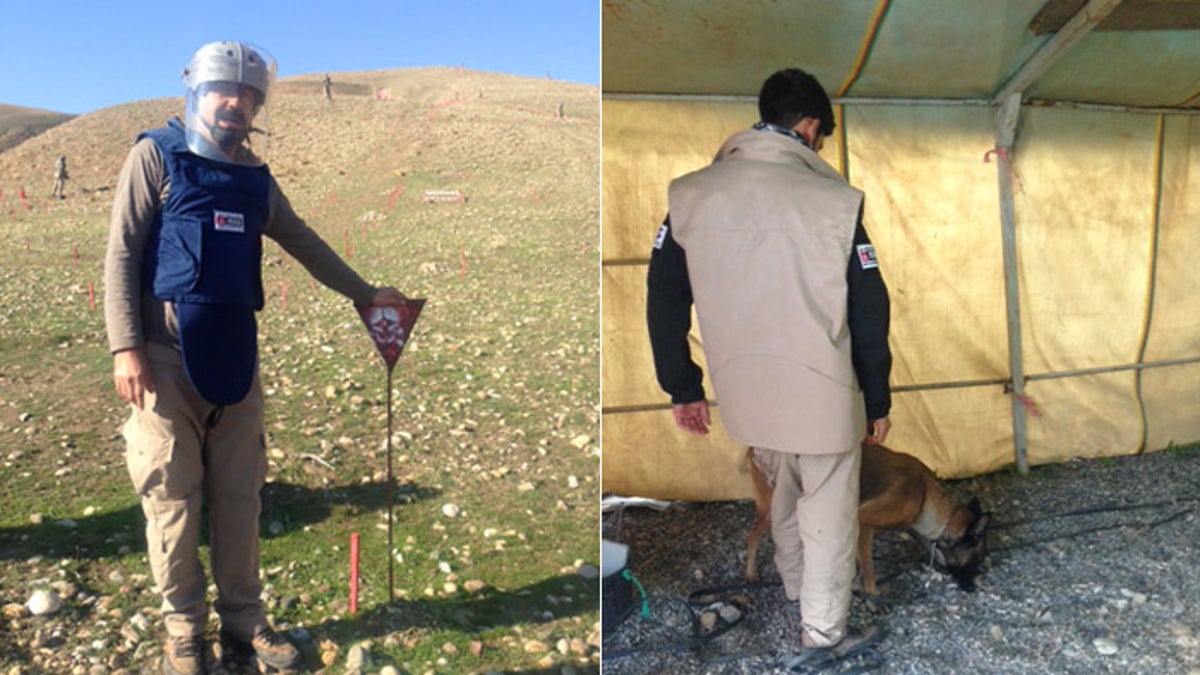
Salaam Muhammed, who works with MAG, stands next to a marker showing a mine has been detected under ground. At right, a MAG dog trainer works with the groups secret weapon for sniffing out mines. (FoxNews.com)
Landmines and unexploded bombs have threatened lives and limbs in Iraq for generations, the vestiges of decades of intense conflict with a host of enemies. Now Islamic State has turned a crisis into a catastrophe.
Infamous for leaving explosive devices and sophisticated booby traps in villages as it retreats, the jihadist army has compounded a problem that has left hundreds of square miles riddled with deadly, hidden bombs. But with violence continuing and funds short, Iraqis and aid workers are desperate to keep children safe as they try to address the hidden threat.
“It’s crucial now to talk about safe behaviors," said Chris Elliot, a community liaison manager with the international humanitarian de-mining organization Mines Advisory Group, during a recent village meeting at a refugee camp attended by young children who escaped from ISIS-controlled regions. "Firstly, we talk about different types of mines and IEDs (improvised explosive device) and how to spot them when they go back to their homes. Then we talk about dangerous areas, and then thirdly we talk about what you would do if you saw a landmine.
"The message is about trying to get the kids to stop or at least run away so they won’t be at harm, and take other kids away and then report it to police or a religious leader,” he said.
[pullquote]
The danger is everywhere. In Jurf Al-Sakhar, a town of 80,000 about 60 miles southwest of Baghdad retaken by the Iraqi army from Islamic State in October, some 3,000 explosives have been found. Authorities are facing the arduous task of trying to stop displaced families from returning to their homes, as the cleanup is expected to take months.
Mines Advisory Group (MAG) is the only international humanitarian de-mining NGO left doing clearance work in the country, and as it stands, can only operate in the northern region of Iraqi-Kurdistan which is bearing the brunt of the refugees. Kurdistan’s rugged military force, the Peshmerga, also attempts to defuse the threat after it takes back towns from ISIS, but is working with little equipment, skills and money to do a guaranteed job.
[image]
“We aren’t working in any areas that the Kurdish Regional Government (KRG) has taken from ISIS. That is where we desperately need funding,” Neil Arnold, the Iraqi technical operations manager for MAG, told FoxNews.com on a recent visit to the region. “Basically we are a charity, so if we want to do something new we have to come to the donors with proposals, and hopefully get the interest and money so we can mobilize and go into these areas.”
While proposals have been drawn up, both local and international donors are typically focused on the overwhelming problem of millions of internally displaced people (IDPs) and spare funds are becoming harder to come by. The efforts by MAG in the Kurdish region are funded in large part by the U.S. Department of State, but with winter now in full-swing and an overwhelming number of refugees seeking basic needs to stay alive, funding has been directed elsewhere with little to spare.
MAG, which currently operates in over 40 countries in the effort to secure the safety of civilians affected by armed violence and conflict, started work to clear landmines in Iraq in 1992. To date, they have cleared almost 77 million square meters of mines and UXO (unexploded ordnance), and handed the terrain back to authorities and communities for use. Almost two million unexploded ordinances have been found and destroyed, and conducted 25,000 risk education sessions to educate civilians on how to detect explosive remnants of war (ERW) and small arms light weapons (SALW) and the appropriate course of action to take.
To further illustrate the message, the children are given coloring sheets with messages to help identify dangerous objects. The organization’s long-term strategy in the region is to respond to the immediate humanitarian and socio-economic developmental need, support local capacities in their ability to counter the contamination, and provide emergency protection to those at risk – which in today’s climate, includes the Syrian refugees escaping the Assad regime and the Internally Displaced People (IDPs) fleeing the infiltration of ISIS.
MAG’s Integrated Clearance Methodology not only involves deploying manual teams to remove and destroy and applying machinery to de-mine at a fast rate, but specially trained mine detection dogs are becoming more and more effective in the clean-up process.
“We have had dogs here for about five years. They are trained on scent recognition, which helps with cost effectiveness. The dogs can do a lot more squares per day than a de-miner,” Arnold explained. “We used to use rollers but they have proven to not be effective. When we arrived in this area we were finding mines in areas that had been deemed clear by rollers.”
However, the issue of landmine clearing remains intensely political and problematic. Due to conflicts between the Iraqi Central Government in Baghdad and the semi-autonomous Kurdish Region Government (KRG) the Kurds have not been issued their 17 percent share thus funding for clearance as a whole is running low. Iraq signed the 2007 Ottawa Anti-Personnel Mine Ban Treaty to ultimately clear all contaminated land within ten years, and that makes Kurdistan obliged to meet the treaty demands – a feat the experts fear is absolutely impossible.
“Donor funding is falling even more, most (people) see Iraq as a middle-income country so it should be funding their clearance as well,” Arnold added. “But it’s not that simple.”
Mylee Cardenas and Jwan Saleem contributed to this report
